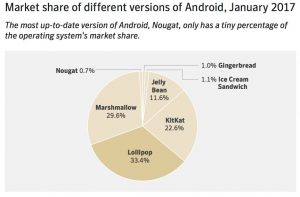Google is not patching its Android mobile operating system for versions earlier than version 4.4 (KitKat)

March 27, 2015. – Google is no longer providing security patches for versions of its mobile operating system, Android, a development of Linux used on smartphones and tablets, which are older than version 4.4 (aka KitKat). This state of affairs very worryingly leaves around sixty percent of Android-powered devices vulnerable to cyber and malware attacks.
As time goes by, Google will stop patching versions older than KitKat
Note that it was August 2017 when I updated this article. I could not find any Android patching information newer than was dated to 2015. As time goes by, Google will stop patching versions older than KitKat.
The following Wikipedia article provides information on the versions that are all named after confectionery.
http://en.wikipedia.org/wiki/Android_%28operating_system%29
Here is the information about Android required to understand this post:
The latest major release to date is Android 5.0 (aka Lollipop)
Android KitKat – 4.4.0 – 4.4.4 up to October 31, 2013
Android Jelly Bean – 4.1.x – 4.3.x July 9, 2012 to July 24, 2013
Google is no longer patching the WebView component in Android Jelly Bean’s default web browser
Android 4.3 (Jelly Bean) uses a key component called WebView in its default web browser that Google is no longer patching, therefore, if cyber criminals find vulnerabilities that can be exploited, they are not going to be fixed. The only remedies would be to upgrade to a later version of Android, which won’t be possible if the device won’t run that version, or buy a device that runs the KitKat or Lollipop versions, which themselves won’t be patched at some future date by Google. This is a serious weakness with the Android operating system, especially since security is becoming more vitally important on mobile devices with every day that passes.
KitKat and later versions of Android uses Google’s Chrome web browser
KitKat uses Google’s Chrome web browser, which can be updated like an app, instead of WebView.
When Apple provides a new version for its iOS mobile operating system, it instructs the users of its phones and tablets to upgrade to the latest version because it supports several generations of phones and tablets. This is not the case with Android. The users have to upgrade their devices to a new version themselves if doing so is possible in the first place, which might not be the case. Even if it is possible to upgrade to a new version, many users of Android’s massive billion user base are not going to do so, as has been proven by Microsoft’s Internet Explorer (IE) web browser. There are still millions of Windows users still using IE8, released in 2009, when IE11, released in October 2013, is the latest version that only runs on Windows 7 and Windows 8.1.
Supporting old versions of software is costly so Microsoft has decided to ditch IE altogether and has made Edge the new web browser in Windows 10, Microsoft clearly wants to get as many Windows users using the same version of Windows and its web browser as possible.
Google has complicated matters by not declaring that it has stopped supporting Jelly Bean completely. Indeed, there are still components of that version that Google is updating and the manufacturers of the devices running it are allowed to create updates for it.
I have the first model of the Tesco Hudl 7-inch tablet, which runs Jelly Bean 4.2.2, that I bought just to gain experience with Android, which is a very user-friendly mobile operating system. The cheap original Hudl runs it beautifully. Its apps are updated, but Android Jelly Bean has not been upgraded. I telephoned Tesco support and was told that I have to stick to Jelly Bean but that I might be able to take the Hudl into a Tesco store and get it upgraded,which, experience tells me, is unlikely to be the case.
It might soon be possible to install Windows 10 on Android phones and tablets
It might soon be possible to install Windows 10 on Android phones and tablets. It that is the case, I will do so because Win10 will be updated with security patches for many years to come. Windows 7, released in 2009 will be getting security patches up to 2020, but since a new version of Android is released every six months or so, it would obviously be best for Google make it possible to use the latest version of Android on several generations of phones and tablets.
Other articles on Android on this website
- – Information on Apple iPad, Google Android and Microsoft tablet PCs/tablets
- – What you need to know about the security and settings of a Google Android tablet or smartphone
- – Samsung updates – Does Samsung update all of its Android phones and tablets to the latest version?
- – Many Google Android devices are easily hacked
- – Password recovery – Recover or reset passwords for Windows – OS X – iOS – Android and Linux devices